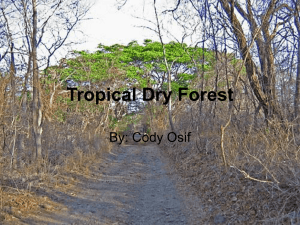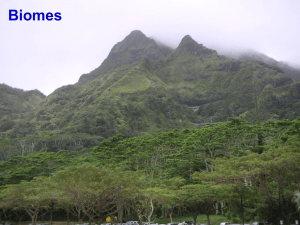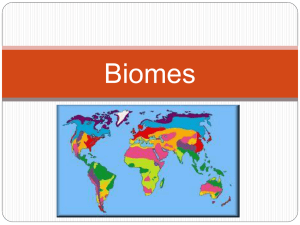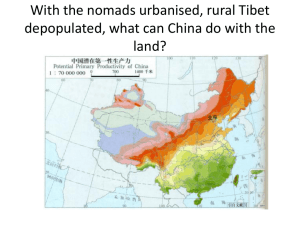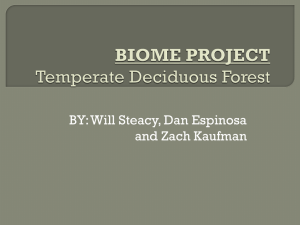Terrestrial Biomes Weather
advertisement
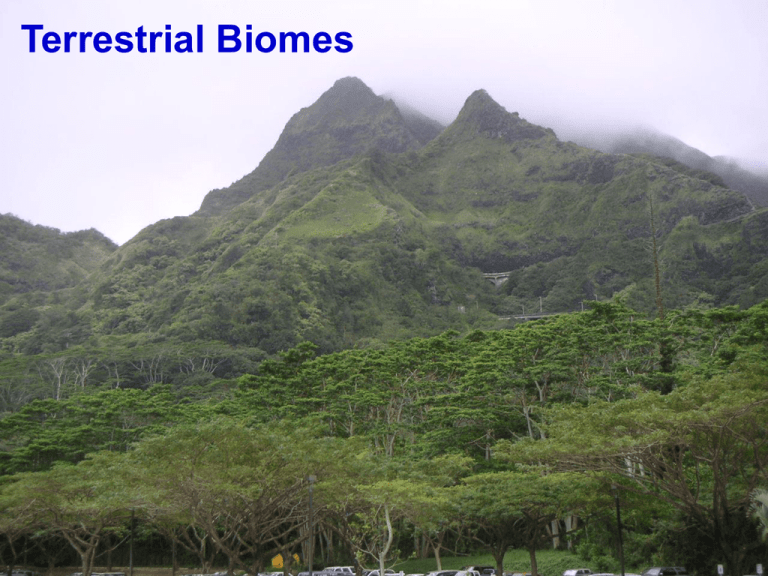
Terrestrial Biomes Weather - particular set of physical properties of the Earth’s troposphere: –Temperature, pressure, humidity, precipitation, sunshine, cloud cover, wind direction and speed Climate – a region’s general pattern of atmospheric or weather conditions, including seasonal variations and weather extremes over a long period. Biome – a large geographical region having a defining climate to which plants show a similar physiological adaptation. Climate Climate and its Effects is the average weather patterns for an area Over a long period of time (30 - 1,000,000 years). It is determined by Average Precipitation and Average Temperature which are influenced by latitude altitude ocean currents and affects where people live how people live what they grow and eat Four Global Temperature Regimes Hot • Tropical • Temperate • Subpolar Cold • Polar Four Plant Types • Succulent – vertical orientation on most parts, no leaves, store water, photosynthesis in tissue – Cactus • Broadleaf Evergreen – keep most of their broad leaves year-round – Tropical trees • Broadleaf Deciduous – drop their leaves when it gets cold (dry in the tropics) – Oak, maple, pecan • Coniferous (cone-bearing) Evergreen Plants – keep their narrow pointed leaves (needles) all year – Pine, spruce, fir Biome Types • Forest – dominated by trees – A lot of precipitation needed • Scrubland – small deciduous trees and shrubs – Some precipitation needed • Grassland – dominated by grasses – Does not need as much precipitation as a forest – Usually needs disturbance to limit tree growth • Grazing, fire • Desert – dominated by succulents – Very little precipitation ‘For plants, precipitation generally is the limiting factor that determines whether a land area is desert, grassland, or forest.’ Temperature and precipitation regulate plant growth, thus the regional distribution of biomes. Boundary lines between biomes are not as distinct as implied here. Global Distribution of Terrestrial Biomes Global Net Primary Productivity For Terrestrial Biomes Net Primary Production of Terrestrial Biomes Biome NPP (g C/m2/yr) Tropical Rain Forest 900 Tropical Dry Forest 675 Temperate Evergreen Forest 585 Temperate Deciduous Forest 540 Boreal Forest 360 Tropical Grasslands 315 Cultivated land (USA) 290 Chaparral 270 Prairie 225 Tundra 225 Desert 32 Extreme Desert 1.5 Desert Desert Biomes • Evaporation exceeds precipitation • Three types of desert depending on average temperature – Tropical (Saudi Arabia) • Always hot – Temperate (Reno, Nevada) • Cool winter / hot summer – Polar (Northwest China) • Cold winter / hot summer Deserts Cold, dry air falls Cell 3 North Moist air rises — rain Polar cap Cell 2 North Arctic tundra Evergreen 60° coniferous forest Temperate deciduous forest and grassland Desert 30° Tropical deciduous forest Tropical 0° Equator rain forest Mostly found in areas that Hadley cells bring dry air. Cool, dry air falls Cell 1 North Tropical deciduous forest 30° Desert Temperate deciduous forest and grassland 60° Cell 1 South Cool, dry air falls Cell 2 South Polar cap Cold, dry air falls Moist air rises, cools, and releases moisture as rain Moist air rises — rain Cell 3 South Desert Can also be caused by a rainshadow Desert • Soils – Often well draining (sand) – Often saline – Thin layer of organic matter • Diversity – Low, but varies with precipitation Desert Survival • ‘Beat the heat’ and ‘Every drop of water counts’ Desert Vegetation • Low-growing, CAM photosynthesis, waxy, reduced leaves • Shallow roots (organic layer), long roots along waterways • Allelopathy/well-spaced (chemical competition) • Drought-resistant seeds. Desert Vegetation Desert plants can not escape the sun. Evolution has shaped them to minimize exposure to the sun. Desert Vegetation • Annual desert wildflowers and grasses store much of their biomass in seeds during dry periods and can remain inactive sometimes for years • In only a few weeks after a rain: – Germinate, grow, flower, produce new seed, die • Desert mosses and lichens – Can dry out completely and remain dormant until the next rain (sometimes for years) – Some museum specimens have been known to recover and grow after 250 years w/o water Desert Animals • Desert animals usually hide from the full strength sun and come out when the temp is lower – Some can become dormant during periods of extreme heat and drought • Seed eaters (herbivores) are common – Birds, ants, rodents • Higher level carnivores: – Snakes, lizards, hawks, owls, coyotes, and some foxes (precipitation dependant) • Water conservation / recycling is key – Kangaroo rat Grassland, Tundra, and Chaparral Biomes • Enough average annual precipitation to allow grass to grow – Erratic precipitation and fires (and sometimes wind) keep large stands of trees from forming • Three types of grasslands determined by a combination of precipitation and temperature: – Tropical, temperate, and polar Tropical Grassland / Savanna • Warm temperatures, low to moderate precipitation, and a prolonged dry season (seasonally wet/dry) • Have some deciduous trees that drop their leaves during the dry season – African savanna – acacia tree – Australian savanna (bush) – eucalyptus tree • African savanna has large herds of hooved animals: – Grazers – grass and herb eaters (Thompson’s gazelles, wildebeests, zebras) – Browsers – twig and leaf eaters (elephants, giraffes) – Reduce competition by eating different parts of the vegetation Temperate Grassland • Seasonal extremes of hot and cold, precipitation falls unevenly throughout the year, windy – Can get very dry in summer and fall: promotes fire • Except along rivers, tree growth is limited by: – Drought, occasional fires, and intense grazing • Soil is very rich in nutrients – Most of above ground biomass dies each year – Great for growing crops (this can lead to high erosion rates) Prairies and Grasslands • Native grazers prevented any single plant from out competing the others. – Introduced domestic grazers (cattle or sheep for example) have different grazing patterns and the floristic composition has been resorted. • Fire is an important component of grasslands. – Some areas may burn every three to five years (lightning) – Keeps trees from becoming established – Stopping these fires can alter the community, allowing trees to grow. Polar Grasslands / Arctic Tundra • Cover about 10% of the Earth’s land surface, just south of the arctic polar ice cap • Most of the year: bitterly cold, very windy, covered with ice and snow – Winters are long and dark • Covered by low-growing plants, mosses, and dwarf woody shrubs adapted to – Lack of sunlight and water, freezing temperatures, and constant high winds – Most growth occurs during the 6 – 8 week summer growing season (almost 24 hr photoperiod) Polar Grasslands / Arctic Tundra • Average temperature is -5°C. – Water is held as ice for most of the year – Decomposition and nutrient cycling is very slow; soils are very rich in organic matter (but poor in usable N and P) – Each year, only the top meter defrosts, below that the ground remains frozen year round – Permafrost – Water at the surface thaws, but cannot permeate the permafrost layer – mosquitoes like this! Tundra • The organic rich soil in the tundra called peat. • Due to the short growing season, all growth and reproduction must happen in a short period. • Young shoots are thus loaded with nutrients – Makes good grazing – Food is so abundant at this time that wading birds, ducks, geese and swans commonly migrate to the tundra; herds of caribou and reindeer arrive and support biting flies, midges, and mosquitoes. – Insects spend the winter as eggs, larvae or pupae. – Birds usually feast on the abundant newly-hatched insects Tundra • Although there are a lot of individual birds, mammals, and insects, there are not many types of species. • Few plant species have evolved to withstand the harsh tundra climate. • Tundra has a low species diversity (# of species) – Naturally low diversity does not mean unimportant. – Tundra is essential to the well-being of animals such as ducks, geese, seals, polar bears, and caribou • Recovery from disturbance takes a long time – Tracks from vehicles are visible for several months Tundra Chaparral • Wet and mild winter climate, dry and mild summer – Found in coastal California, Israel, parts of South America and Australia – Mediterranean climate • The summer drought is what drives this biomes ecology – Fires important • Plants either limit the water they lose, or gain as much water as possible Chaparral • Plants can limit water loss by producing small hard green leaves – Hardness due to a waxy outer covering used to prevent water loss – Most of these plants are evergreen, so they can photosynthesize during the wet part of the year – By retaining leaves year round – they are able to take advantage of all rainfall • Plants can gain as much water as possible – Deep tap roots – Extensive root system (bare ground between plants) Chaparral • Eradication of top predators when these areas are settled leads to a proliferation of herbivores. – Sometimes, native herbivores have been replaced with goats – Goats are indiscriminate browsers and kill many of the plants they eat – Overgrazing has reduced many Mediterranean hillsides to bare rock with very few patches of vegetation – Urbanization in California Chaparral Forest Biomes • Moderate to high average annual precipitation • Three types depending on temperature: – Tropical, temperate, boreal (polar) • All contain trees and various types of vegetation Tropical Rain Forest • Broadleaf evergreen forest found near the equator • Warm annual mean temperature (little month to month deviation), high humidity, almost daily rainfall • Distinct layers based on need for sunlight – – – – – Emergent layer – tallest trees (most sunlight) Canopy – top of tall trees Understory – small trees Shrub – shrubs and short plants Forest Floor – ground layer (least sunlight) Tropical Rain Forest • Huge diversity (Different layers support different life) – Perhaps 50 - 80% of all terrestrial organisms on Earth inhabit these forests. – Temperate forest may have 20 - 30 tree species per hectare (2.47 acres); rain forests can support more than 350 – 450 tree species per hectare • To fit that many tress each species may only be represented once or twice • Most productive terrestrial biome – High temp, moisture, uninterrupted growing season – Decomposers / nutrient cycling – Remember – nutrient poor soil! Tropical Forest • Key feature is constant temperature – Average temperature from one month to the other is usually within ± 2C – However, daytime temp may be 34 C during the day and 20 C at night. • Much rain: annual rainfall ranges from 2,000 mm to 15,000 mm (79 – 591 inches; 1.6 inches per day). • Wet and dry seasons – Length of dry season determines the areas ecology Tropical Forest • Long Dry Season – Dry season = 6-8 months – Many trees drop their leaves during the dry season not to escape cold, but to prevent overheating • Short Dry Season – Dry season < 3 months – Tropical rain forest: 2,300 – 5,000 mm of rain per year (extreme years some places may get 15,000 mm = 50 feet). Tropical Rain Forest Tropical Deciduous Forests • A little farther away from the equator • Wet / Dry season – Lower canopy – Deciduous trees drop their leaves during the dry year (some drought resistant evergreen trees) • Long dry season areas = tropical scrub forests – Small deciduous trees and shrubs Temperate Deciduous Forest • Moderate average temperatures that change seasonally – Long, warm summers – Cold, but not too severe winters – Abundant precipitation, often spread evenly throughout the year • Dominated by broadleaf deciduous trees – Oak, maple, hickory, sycamore, and poplar – Relatively slow decomposition = high soil nutrients – More sunlight hits the forest floor • Rich diversity of plant life at ground level Boreal Forest • Great fir forest of Canada and northern Eurasia. • Vegetation type is defined by seasonal expansion and contraction of the Arctic and continental polar air masses. – Polar air in the winter, continental air in the summer – Very cold winters, relatively warm summers so trees can survive Boreal Forest • Many trees look like Christmas trees, not oak trees – Shape of tree is related to the ability to shed snow – Broken trees are not good competitors • Leaf morphology is important – Needles are more durable, can photosynthesize year round – conserve heat more efficiently • Boreal forests are low in species diversity, but not as low as tundra Boreal Forest Tropical Mountains • Go from tropical forest to shrubs to ice as you move up in altitude. – Similar phenomena seen as you move from the equator north Tropical Mountain High Alpine Tundra Elevation Low Tropical Forest Tropical Forest High Temperate Deciduous Forest Northern Coniferous Forest Moisture Availability Arctic Tundra Low Tropical Mountains


